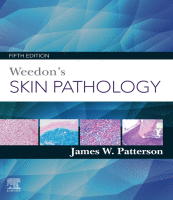Physical Address
304 North Cardinal St.
Dorchester Center, MA 02124

Introduction Various physical agents, such as trauma, heat and cold, radiation, and light, may cause lesions in the skin. This is not an exhaustive account of all the reactions that can theoretically result from physical injuries because some are of…

Introduction A drug reaction can be defined as an undesirable response evoked by a medicinal substance. Any drug is a potential cause of an adverse reaction, although certain classes of drugs can be incriminated more often than others. Major offenders…

Not unexpectedly, there are conditions encountered in dermatopathology that defy orderly classification, having neither a consistent tissue reaction pattern nor a recognized infectious cause. However, in the case of confluent and reticulated papillomatosis, current evidence does point to an infectious…

Introduction This chapter covers a diverse group of diseases that have in common a disturbance in metabolism or body function. Many of these conditions have a genetic basis, most of which have been elucidated in the past three decades. Three…

Introduction The panniculus adiposus (subcutaneous fat) is a metabolic depot that also functions as a layer of insulation and as a buffer to trauma. It is composed of mature lipocytes, which are round to polygonal cells with an eccentric nucleus…

Introduction A cyst is an enclosed space or abnormal sac within a tissue, usually containing fluid or semisolid matter and lined by epithelium. Cysts are usually classified on the basis of their pathogenesis. In the skin, the most important cysts…

Introduction This chapter covers the nontumorous disorders of the cutaneous appendages, the great majority of which are inflammatory diseases of the pilosebaceous apparatus. Inflammation of the apocrine and eccrine glands is quite uncommon by comparison. Hamartomas and some related congenital…

Introduction Cutaneous deposits are a heterogeneous group of substances that are not normal constituents of the skin. They are laid down, usually in the dermis, in a variety of different circumstances. There are five broad categories of deposits ( Table…

Introduction The mucinoses are a diverse group of disorders that have in common the deposition of basophilic, finely granular, and stringy material (mucin) in the connective tissues of the dermis (dermal mucinoses), in the pilosebaceous follicles (follicular mucinoses), or in…

Introduction Normal elastic tissue Elastic fibers are the important resilient component of mammalian connective tissue, and their presence is necessary for the proper structure and function of the cardiovascular, pulmonary, and intestinal systems. Their structural role is to endow tissues…